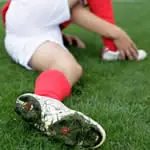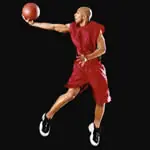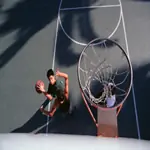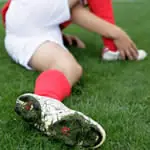Inside Foot 1-2 Step
This is the most effective and fundamentally sound way to shoot a jump shot. Period. Many coaches still prefer the inside foot 1-2 step because when the shooter spots up and tends to be standing still, it is used to generate lift and rhythm for the shot. It also is a very effective way for the shooter to regain balance and control when on the run from the left, right or straight ahead.
When the shot is actually taken, proper shooting footwork is the same as the basic ready position except that the right foot is slightly ahead of the left foot to line-up the body towards the target (the basket). The shooter's feet should be in the ready position long before the ball is passed.
Statistically, most missed jump shots hit the front of the rim. Expert shooting coaches with training in behavioral science can predict that a shot will be missed as the shooter catches the basketball or as the player picks up the basketball off the dribble. This is easy because we can see that the shooter was not truly ready to shoot before catching/picking the ball up off the dribble. Also, this is an indicator that the shooter's mindset is only ready to take the shot, but not ready to make the shot. This concept is a topic for another article, but is pertinent here because preparing in advance of receiving the basketball to execute the inside foot 1-2 step can be an indicator of the shooter's focus to make the shot.
If dribbling, it is best to make the first step into the shot with the inside foot, which is always the foot closest to the basket, when the player is not directly and straight ahead facing the basket. Off-the-dribble or catch-and-shoot, always step into the basketball with inside foot 1-2 step footwork. When the shooter's feet and shoulders are already facing straight ahead towards the basket, a right-handed player's footwork should go in the left--right order. This allows the player to brake, stop and gain balance and control utilizing the dominant leg. The left foot should touch the floor, heel first. The right foot should come forward and point towards the basket.
The two-foot jump stop has become popular with many coaches and players. It too can also be very useful when doing a step-back jump shot, moving very fast going left or needing to use a quick release shot. However, research has shown that when players learn the 1-2 step jump shot first, they actually will use the two-foot jump stop shot when pressured or rushed. What is intriguing is that this often occurs when the player has never practiced this technique because the player has already learned to control their momentum to stop and square up to the basket from using the 1-2 step jump-shot.
Finally, many players step or hop into a 1-2 step or jump-step after they catch the ball thinking that they are gaining the advantage of this footwork. Using either the 1-2 step or the jump stop, the player receiving the basketball should use this footwork as they catch the basketball. Said another way to make this concept even clearer, players should use this footwork, in order to catch the basketball.
In conclusion, striving to master these 10 footwork techniques in everyday practice and training workouts will enhance both basketball conditioning and is critical for proper skill development. Practicing pivoting is not easy; it's hard and sometimes monotonous work. Everyone wants to practice shooting or just go out and play games. However, learning, practicing and utilizing proper footwork can change a player's game for the better and separate them from the rest of the pack!
Most top coaches understand that the best players in the history of basketball, from George Mikan, Bill Russell and Oscar Robinson, to Magic Johnson, Larry Bird and Michael Jordan, have all utilized proper footwork to gain an edge over opponents. The next time you see highlights of these guys, watch and look for what you can learn from their footwork!
- 3
- of
- 3






Discuss This Article